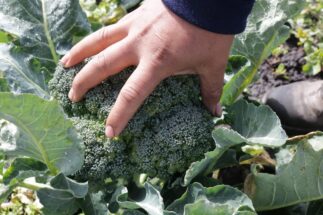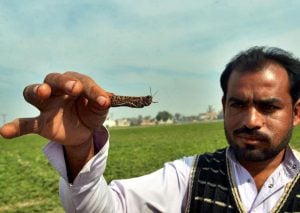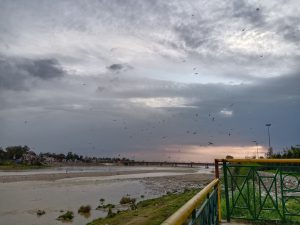India’s complete lockdown to contain the spread of the Covid-19 pandemic has upended the agrarian economy of the South Asian nation. It could have a serious impact on farm production in the main summer cropping season, work for which starts in May.
Farmers in India are no strangers to crisis, but the current disruption due to the pandemic is unprecedented. The government must come forward to succour smallholder and marginal farmers in particular through a fiscal stimulus package that should include unconditional cash transfers for poor rural households to tide over the situation, economists and agricultural experts said.
Prime Minister Narendra Modi imposed a 21-day nationwide lockdown in March 24, which he extended for another 19 days to May 3. Covid-19 has infected at least 33,000 in India, and more than a thousand have died already, the latest data shows. Compared to many other countries, these numbers are low, and the government says the relative success is due to the stringency of the lockdown. But that has had disastrous consequences for farmers.
There are more than 145 million farmers in India, according to the Agriculture Census 2015-16. Assuming five persons to a household, there are 725 million people, or more than half of the country’s population, who depend on agriculture and allied activities for a living. As many as 82% of the farmers are smallholders, Food and Agriculture Organisation data show. It is this massive segment that has been hit the hardest due to the lockdown forced by the Covid-19 pandemic.
Even before the lockdown led to labour shortages and brought transportation of farm produce to a virtual halt, farmers were staring at losses in the winter harvest due to unusually heavy rainfall in March that flattened the crop in many locations across the country. In the one province of Uttar Pradesh alone, crops worth nearly INR 2.55 billion (USD 33.6 million) were damaged by hailstorms in 35 districts by the middle of March, affecting more half a million farmers.
See: Farmers hammered by unseasonal rain, Covid-19 lockdown
Much damage done
Although authorities declared agriculture an essential service that could continue during the lockdown, much damage has already been done during the lockdown. Stranded trucks on highways were abandoned by drivers and bringing them back is still proving to be a challenge. Long supply chains remain broken in many parts of India, said Satyabrata Acharyya of Professional Assistance for Development Action (Pradan), a grassroots non-profit that works with nearly 850,000 rural households. “Farmers near urban centres are better placed since short supply chains are mostly functional,” Acharyya said.
Farmgate prices of fruits, vegetables, milk, meat and poultry have crashed across the country because of lowered demand and logistics restrictions, plunging smallholder farmers into distress since they depend on these for regular cash flow. “High-value agriculture has been badly hit,” said Ashis Mondal, director of the non-porofit organisation, Action for Social Advancement (ASA), which works with 179,000 smallholder farmers in Madhya Pradesh, Chhattisgarh, Bihar and Jharkhand.
The sharp drop in demand, erratic functioning of wholesale produce markets and disruption in marketing services have led to vegetable cultivators abandoning as much as 30% of the crop, which remains unharvested, according to reports. This has added to the financial stress among vegetable farmers, a large majority of whom cultivate less than two hectares of land.
The poultry sector, which employs some 1.5 million smallholder farmers, has been one of the worst-hit. Demand for broiler chicken and eggs fell precipitously on rumours linking them to Covid-19, according to Avinash Paranjape, founder trustee of National Smallholder Poultry Development Trust. “Small, backyard poultry farms have been dealt a crippling blow and progress made in the past decades have been completely wiped out. Right now, it is uncertain whether smallholder poultry farmers – many of whom are women – will be able to recover at all.”
In the initial weeks of the lockdown, the meat trade in the country also collapsed and milk supply was thrown into disarray. “This has caused distress to livestock farmers, who need a continuous cash flow to keep their animals fed,” said livestock expert Sanjeev Kumar, founder of Goat Trust. Rearing goats is like an insurance for poor rural households and not being able to sell them in times of need leaves them short of cash for survival, Kumar said.
The intermittent supply of animal feed is adding to the problem. “The government must make livestock feed available to farmers on a priority basis,” Kumar said. “We cannot let livestock go hungry. It will lead to productivity losses that farmers will find difficult to cope with.”

Besides animal feed, farmers are also worried about potential shortages in farm inputs such as seeds and fertilisers ahead of the summer cropping season. More than 60% of the farmland in India depends entirely on rainfall. The main source of rainfall in the country is the June-September southwest monsoon, which would be average this year, the India Meteorological Department predicted in its first monsoon forecast of the year on April 15.
It means farmers must prepare their fields and start buying seeds and fertilisers this month. Typically, March, April and May are the peak activity season for seed processors. This has been severely disrupted due to the lockdown. Seed processing is essentially decentralised in India and government agencies manage only a fraction of it. This year, seed processors have not functioned properly.
Since local authorities in many parts of the country are restricting movement of trucks loaded with agrochemicals, seeds and fertilisers, there is potential for a shortage of these key inputs for the kharif (summer) sowing season.
“If there is a scarcity, which seems likely, and prices of seeds rise, it will place smallholder and marginal farmers in a fix,” said Mondal of the ASA. Farmers with large landholdings have already placed orders, putting an upward pressure on prices. “This could make seeds unaffordable to smallholder and marginal farmers.” Acharyya of Pradan said many smallholders will have to make do with seeds preserved at home.
India needs about 25 million quintals (1 quintal = 100 kg) of seeds for the kharif season, according to the National Seed Association of India (NSAI). Seed production that starts from the fields is complex and requires growers, processors, testing labs, packagers and transporters working in tandem. The lockdown has disrupted this completely.
“The farm input ecosystem has collapsed, and the government should allow all sub-trades and manufacturing units associated with agri-inputs to function,” said Indra Shekhar Singh, director of policy and outreach at the NSAI. “We need to make informed decisions so that Covid-19 does not threaten our agriculture and food supply.” The seed industry needs a special stimulus package, particularly for small and medium companies, Singh said.
There is trouble at the fertiliser front as well. Many fertiliser plants were shuttered in the initial weeks of the lockdown and most of them are not yet fully functional. “There is now concern over the potential impact on a market such as India given its high population and from a fertiliser perspective, given its prominence as an importer, producer and consumer,” market intelligence provider IHS Markit said in a note.
For pesticides, even after the lockdown is lifted, it would take at least a week to restore production to normal levels, particularly due to labour shortages.
Essential supplies of chemicals have been halted at various checkpoints across the country, according to Chemical Watch, a specialist information provider. These disruptions in production and supply are likely to harden prices and availability, which again impacts smallholder farmers the most.
Immediate financial stimulus
Many economists, including Nobel laureates Amartya Sen and Abhijit Banerjee, and the former governor of Reserve Bank of India (RBI), Raghuram Rajan, have advocated several steps to counter the unexpected loss of income. Even if the meals are secured for now, farmers need money to buy seeds and fertiliser for the next planting season, they said, adding that the government has partly recognised this in the cash transfers it has promised to certain groups, but the amounts are both small and narrowly targeted.
“Cash transfers have been announced but they may be inadequate,” said Usha Thorat, former deputy governor of the Reserve Bank of India (RBI). “I do think cash transfers to the poor has to be a part of the further fiscal package, as also MGNREGA.”
The Mahatma Gandhi National Rural Employment Guarantee Act of 2005, or MGNREGA, ensures 100 days of work in a year to poor rural households. There have been calls from experts to significantly expand the reach of MGNREGA funding in rural areas, along with free rations through the public distribution system.
People working with smallholders say there has to be unconditional cash transfers to farmers so that they can cope with the current situation. “Given the severe shortage of cash, the government can help by providing smallholder and marginal farmers INR 5,000 (USD 67) every month for the next 4-5 months,” said Mondal.
Acharyya, pushing for cash transfers of INR 7,500-10,000 (USD 100-133) to smallholder farmers, said the government has the capability to do this easily. “More than 100 million farmers now have bank accounts under the Pradhan Mantri Jan Dhan Yojana. The government needs to immediately transfer money to these accounts before the onset of the kharif season.” He also said that state governments must activate MGNREGA proactively.
“There cannot be any shutdown in agriculture. Work must go on,” said Mondal. “We cannot leave the majority of our farmers in the lurch.”
![<p>In India, a lot of the winter wheat crop had to be harvested by hand because farmers found it almost impossible to rent harvester combines during the lockdown forced by the Covid-19 pandemic [Image by: Pixabay]</p>](https://dialogue.earth/content/uploads/2020/05/Indian-farmer-in-wheat-field-by-Jeevan-Singla-Pixabay.jpg)








